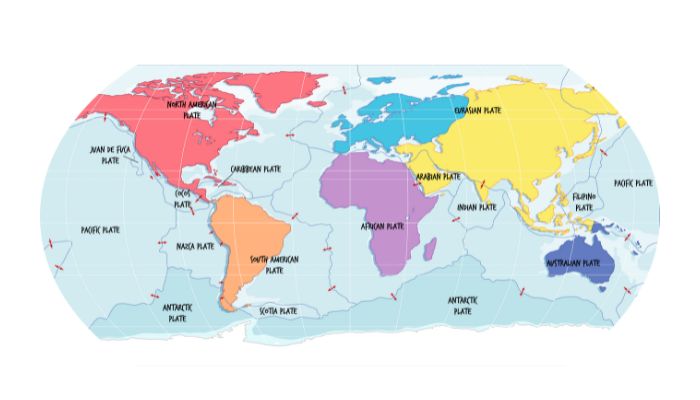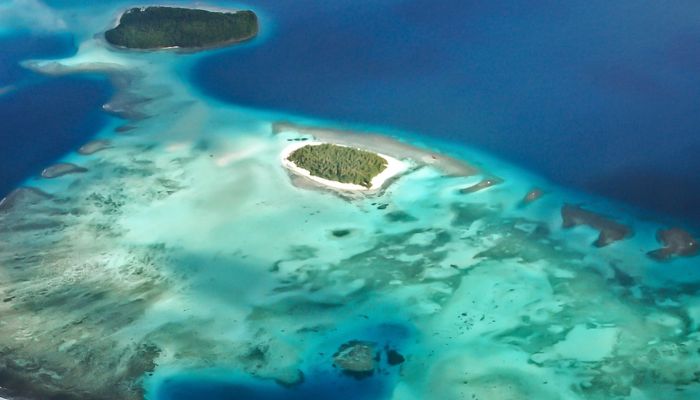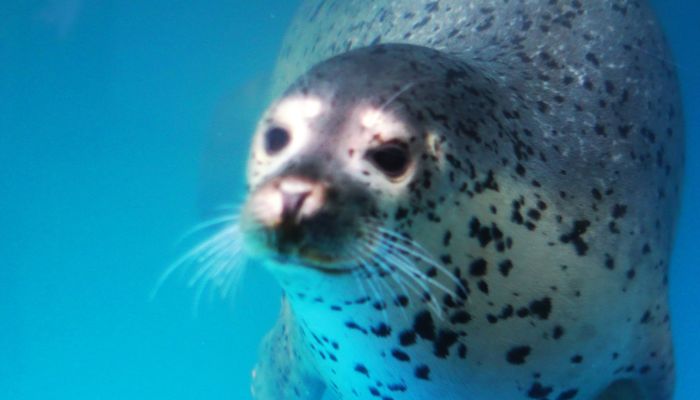

The Pacific Ocean is the largest ocean in the world, stretching from the Arctic to the Southern Ocean, going from the Bering Sea to Antarctica’s Ross Sea. It is joined to the Atlantic via the Bering Strait on the northern side, while the Drake Passage and the Magellan Strait link it from the south.
To its east lies the Americas, while towards its western boundary are the Asian and Australian landmasses. It is also divided into the North and the South Pacific Oceans by the Equator.
The Pacific Ocean covers over 30% of the earth’s surface area. To put it in perspective, it is double the size of the Atlantic Ocean and has twice the volume of water compared to the former. Secondly, it is bigger than the combined surface area of all the continents.
The Pacific Ocean covers about 63.8 million square miles and has 714 million cubic km of water. It also has many marginal seas and water bodies like the Bering Sea, Coral Sea, Okhotsk Sea, the Sea of Japan, the South and East China Sea, and the Tasman Sea. Prominent Gulfs include the Gulf of Alaska and the Tonkin Gulf.
The deepest ocean on the planet has many interesting geological features and other mind-boggling facts which will be discussed in this article.
The Spanish expedition in 1519 led to the discovery of the Pacific Ocean by the Portuguese Navigator and Explorer Ferdinand Magellan. He was headed to the Spice Islands with five ships and 270 men, which would result in their circumnavigating the globe.


He sailed between the southernmost end of the South American mainland and the Tierra Del Fuego archipelago. He found the ‘Strait of Magellan’, which connects the Atlantic with the Pacific Ocean.
After crossing the rough and stormy waters off Cape Horn, he found calm waters when he entered the Pacific. Hence he called the expansive ocean ‘Pacifico’, meaning Pacific, peaceful or tranquil. However, till the 18th century, the ocean was also called the Sea of Magellan.
We all know Mount Everest as the tallest mountain peak on earth; however, the underwater mountain known as Mauna Kea could put the former to shame as it’s much higher than Everest. The only difference is that it rises from the ocean bed.
Mauna Kea is a volcano which is over a million years old. It is dormant or inactive, and its lava is quite viscous, creating a more steep profile.
While Everest is around 8848 m tall when measured from the base to the peak, Mauna Kea is 10,210 m high. It rises from the seabed, and its peak is the highest point in Hawaii.
The Pacific Ocean has many archipelagoes or groups of islands. It also has many coral reefs and platforms of corals. Most islands are situated south of the Equator, in the Southern Pacific.
There are three huge island groups: Melanesia, Polynesia and Micronesia. Even the world’s second-largest island, New Guinea, a part of Melanesia, is in the Pacific Ocean.
Other prominent archipelagoes in the Pacific Ocean include Fiji and the Hawaiian Archipelago. They are a famous tourist destination and make the Pacific one of the most visited places in the world.


The Easter Island and the Galapagos islands are also quite famous, especially for their wildlife and culture.
Also, the rich flora and fauna have made the Pacific a place of research among ecologists, climatologists and environmental experts.
The majority of the atolls are also found here. Atolls are islands made of coral colonies usually enclosed or surrounded by lagoons. They are found in warm waters of the oceans. In the Pacific, the Coral sea islands west of the Great Barrier Reef are picture-perfect.
Many large island nations are located amidst the Pacific. They are made of a cluster of islands or small groups of islands close to each other. These include Indonesia, which is the biggest archipelagic nation in the world. Other island states are Japan, New Zealand and the Philippines.
Apart from being the deepest ocean in the world, the Pacific Ocean also has the deepest trench, the Mariana Trench, whose deepest part is known as the Challenger Deep. This trench was explored in 1875 by HMS Challenger.
In 2012, the famous director of titanic, James Cameron, also set a record by making the first solo trip into the Deep. It lies 10,944 m below sea level and is the deepest part of any ocean. It is situated at the bottom of the Mariana Trench, which was formed due to tectonic plate interactions.
The Mariana Trench is 11,034 m deep, and its depth is more than the height of Mount Everest. It is said to have formed 180 million years ago, making it one of the oldest seabeds.
The South Pacific has the remotest location on earth, farthest from any landmass. Known as Point Nemo or the Oceanic Pole Of Inaccessibility, it was discovered in 1992 by a surveyor Hrvoje Lukatela.
Point Nemo is 34 times bigger than France and has weak currents, fewer nutrients and scarce marine life.


To reach the closest lands, one will have to travel over 2685 km, which makes Point Nemo the farthest, most desolate and uninhabited place on the planet. However, even here, plastic pollution has become a grave problem.
Since it lies away from human settlements, it is used as a ‘space cemetery’ by international space agencies and institutions to crash their rockets, satellites or freighters when they become no longer useful.
Over 250 spacecraft lie four kilometres below the surface of the water in Point Nemo, making it a spacecraft cemetery.
The Pacific Ocean is home to the world’s most extensive coral reef system, which is the Great Barrier Reef. It is a place of breathtaking beauty, lying on the northeastern coast of Australia.
The largest coral reef in the world spans over 1429 miles and was designated a UNESCO World Heritage Site in 1981. It has around 2500 coral reefs, with 400 different corals supporting 1500 types of fish and 4000 kinds of molluscs.
It is also the site of extensive scientific research and is full of marine life. Species like the dugong or the sea cows, or the rare large green turtles, which are endangered, live near the coral reefs.
The Pacific Ocean is shrinking by an inch annually due to the movement of tectonic plates, whereas the size of the Atlantic is increasing by one inch every year. This phenomenon is happening on the three sides of the pacific ocean basin.


Also another interesting fact is that at its broadest point, the pacific ocean’s diameter is five times bigger than the moon’s diameter.
Gyres are ocean currents created due to the rotation of the earth on its axis and also the position of its continents. They are responsible for redistributing the sun’s heat and essential nutrients across the world’s oceans which marine animals and plants depend on for their life and survival.
There are five main gyres in the world, out of which two occur in the Pacific. The North Pacific Gyre circulates above the Equator. It runs in a clockwise direction from California to Japan.
Lying below it is the South Pacific Gyre. It flows to the opposite side, and these currents sweep away heaps of garbage floating in the Pacific and deposit them in certain areas, such as the Pacific Garbage Patch.
The Pacific Ocean has several volcanoes that create a crescent-shaped ring around the basin, hence its name, the Ring of Fire. This area is prone to high seismic activities and tsunamis due to tectonic and ocean plate movements.
Around 75% of the world’s active volcanoes are found here. The most popular eruption happened in 1883. The Krakatoa volcanic island erupted, killing thousands.


The incident was well recorded in history as it led to the death of 37,000 people. Many others were injured due to earthquakes and clouds of dust, as well as powerful storms and tsunamis.
The Pacific Ocean coasts are rich in reserves of petroleum and natural gas. They are particularly abundant in Australia and New Zealand. Their extraction is carried out in shallow waters, mainly near the continental shelves.
Apart from these, pearls are harvested near the coasts of Japan, Nicaragua, Panama, Papua New Guinea, Australia and the Philippines.
Much of the world’s seafood is caught in the Pacific Ocean. Delicacies like tuna, salmon, shellfish, swordfish, sardines, snapper, herring etc., are abundant.
The waters of the Pacific are a source of raw materials like minerals, gravel and sand for the construction industry.
Lastly, critical maritime routes pass through the Pacific. It aids in the marine transport of goods across the globe, making transportation easier and cheaper. Its navigable waters offer transportation services from the east to the west and vice-versa.
The strategic routes go from Taiwan to Singapore, and the region is the Torres Strait which is situated in Oceania.
Majestic mammals like different species of whales, sea otters, seals, turtles and sea lions live and thrive in the Pacific waters. Scientific researchers and biologists are concerned about their future, given the increasing shipping activities and the plastic pollution in the ocean waters.


There are other issues, such as illegal fishing and hunting, which are a looming threat to the marine life of the Pacific ocean. These activities have disrupted the natural balance of the ecosystem. Another persistent issue is oil pollution in the South Pacific Ocean and the South China Sea.
These man-made problems, coupled with climate change, are taking a toll on the ecosystem of the Pacific, hence efforts must be made to protect the vibrant underwater life of the world’s greatest ocean.
The Pacific Ocean was officially found in 1521; however, people have travelled through it from time immemorial. Historians have evidence of communities using canoes in the waters around Taiwan as the importance of maritime trade and exchange was growing.
Navigation and travel might be more dangerous than and relied on primitive modes and methods; however, it did exist. Archaeologists claim that evidence of human migrations near the Bering Strait dates to 30,000-16,000 years ago.
However, it was somewhere in 3000 BC that the earliest humans undertook sea voyages and travelled through certain parts of the Pacific Ocean.
You might also like to read-
Disclaimer: The author’s views expressed in this article do not necessarily reflect the views of The Marine Learners. Data and charts, if used in the article, have been sourced from available information and have not been authenticated by any statutory authority. The author and The Marine Learners do not claim it to be accurate nor accept any responsibility for the same. The views constitute only the opinions and do not constitute any guidelines or recommendations on any course of action to be followed by the reader.
The article or images cannot be reproduced, copied, shared or used in any form without the permission of the author and The Marine Learners.










We believe that knowledge is power, and we’re committed to empowering our readers with the information and resources they need to succeed in the merchant navy industry.
Whether you’re looking for advice on career planning, news and analysis, or just want to connect with other aspiring merchant navy applicants, The Marine Learners is the place to be.